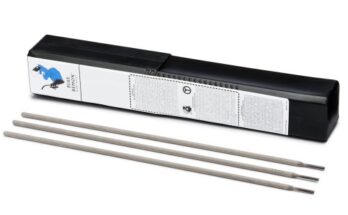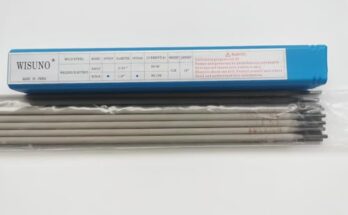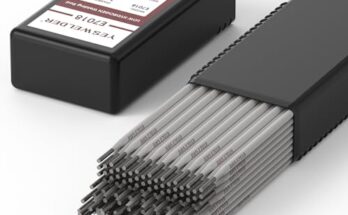Need to tackle a tough welding job? Let’s explore the world of 6010 welding rod and discover its capabilities. This comprehensive guide will teach you everything from its basic properties to advanced applications.
The 6010 welding rod is a type of electrode used in shielded metal arc welding (SMAW), often
called stick welding. It’s known for its excellent penetration and ability to weld in all positions, even overhead. This makes it a favorite for various applications, especially those requiring deep penetration welds on materials like steel. Its cellulose-based coating produces a highly fluid weld pool, aiding in penetration even with challenging situations such as vertical up welding. The cellulose coating also helps protect the weld from atmospheric contamination, leading to a cleaner, stronger weld. Compared to other electrodes like 7018, the 6010 excels in its ability to tackle dirty or rusty metals and is much more forgiving for beginners when tackling vertical welds. I remember my first time using 6010; the deep penetration was impressive, even on a slightly rusty piece of scrap metal I was practicing on. The arc was much more stable than I anticipated, especially when welding in the vertical up position.
Key Features and Benefits of 6010 Electrodes
The 6010’s success stems from several key features. Its deep penetration is unmatched by many other electrodes, making it ideal for thicker materials and applications requiring a strong, robust weld. The fast freezing speed of the weld pool reduces distortion and improves the overall weld quality. The cellulose coating offers good shielding, minimizing spatter and ensuring a consistent weld bead even in windy conditions. One particular advantage I’ve noticed is its versatility in various welding positions – flat, vertical, horizontal, and overhead. This makes it an extremely valuable tool in both workshop and field settings. This versatility is a huge advantage when working on a project with varied welding requirements; you don’t need to switch electrodes for different positions. Think of it like having a multi-tool in your welding arsenal.
6010 Welding Rod vs. Other Electrodes
While 6010 boasts exceptional penetration, it’s crucial to understand its limitations compared to other electrodes, like the popular 7018. 7018 is known for its superior weld quality in terms of appearance and mechanical properties, often preferred for critical structural welds or applications requiring higher tensile strength. However, 7018 is far more challenging for beginners, especially in vertical and overhead positions, and it doesn’t handle dirty metal as well. In essence, 6010 excels in penetration and ease of use in all positions, but 7018 prioritizes weld quality and strength in flatter positions. Consider this comparison similar to the difference between a powerful but less precise hammer versus a finely tuned chisel; one is better for brute force, the other for detailed work. The choice depends on your specific needs.
Applications of 6010 Welding Rods
Welding Steel
The 6010 rod finds its most common application in welding steel. Its deep penetration capabilities make it suitable for thicker steel plates where a strong, penetrating weld is crucial. This is particularly important in construction, fabrication, and repair work where structural integrity is paramount. For instance, when welding large steel beams or repairing heavy machinery, the 6010’s ability to fuse the metal deeply ensures a strong and reliable joint. I’ve personally used 6010 extensively in repairing agricultural equipment where the welds need to withstand significant stress. The penetration is key in these scenarios.
Pipe Welding
Pipe welding, especially in vertical positions, is another area where 6010 shines. Its deep penetration and ability to weld in all positions make it a practical choice for various pipe diameters and configurations. The fluid weld pool ensures complete fusion, preventing gaps or weak points. This is critical in applications such as pipeline construction and repair, where leaks can have severe consequences. When working on a plumbing project, I find 6010 to be incredibly helpful, providing reliable welds, even in confined spaces where access is limited.
Other Applications
Beyond steel and pipe welding, 6010 can be used in a variety of applications. While not ideal for all situations, its robustness and versatility extend to the repair of heavy machinery and equipment, creating structural components in fabrication work, and even in some types of automotive repair. However, always remember to choose the right electrode for the specific job; 6010’s limitations in cosmetic weld appearance should be considered. You won’t want to use it on a show car, but it’s perfect for a farm tractor.
Choosing the Right 6010 Welding Rod
Diameter and Length Considerations
6010 rods are available in various diameters and lengths. The diameter selection depends primarily on the thickness of the material being welded and the desired weld penetration. Thicker materials generally require larger diameter rods. The length typically ranges from 14 inches to 18 inches, with the longer lengths offering longer welding time before needing replacement. Proper electrode selection can significantly impact your welding efficiency and the quality of the weld. Choosing a diameter that’s too small for the material can result in poor penetration and a weaker joint; conversely, using too large a diameter can lead to excessive heat input and potential warping.
Current and Voltage Settings
Proper current and voltage settings are crucial for optimal performance with 6010 electrodes. These settings depend on the rod diameter and the thickness of the base metal. Using a welding machine with adjustable current and voltage allows for fine-tuning based on the specific application. Incorrect settings can lead to poor arc stability, excessive spatter, or insufficient penetration. I always recommend starting with the manufacturer’s recommended settings and making adjustments based on your observations of the weld pool and arc behavior. Monitoring the arc characteristics helps determine whether a higher or lower setting is needed. Experimentation and practice are key to mastering the technique.
Manufacturer and Quality
The quality of the 6010 rod can significantly impact your welding results. Different manufacturers offer various levels of quality, affecting the arc stability, penetration, and overall weld quality. Choosing reputable brands known for consistent product quality is essential for reliable welding results. It’s analogous to choosing a premium brand of paint over a cheaper alternative for a better finish. Opting for a quality rod from a well-known manufacturer means consistency in performance and greater reliability on the job, saving time and frustration in the long run.
Safety Precautions When Using 6010 Welding Rods
Personal Protective Equipment (PPE)
Safety should always be the top priority when welding. This means using appropriate PPE, including a welding helmet with appropriate shade, welding gloves, long-sleeved clothing made of flame-resistant material, and sturdy closed-toe footwear. Eye and skin protection is crucial to prevent burns and damage from intense UV radiation. I always remind my apprentices that a few extra seconds spent preparing with proper PPE is far more valuable than the regret of injury. The cost of neglecting safety is far greater than investing in proper protection.
Ventilation and Workspace
Welding generates fumes and sparks, which can be hazardous to your health and environment. Working in a well-ventilated area is crucial, especially outdoors or in a space with appropriate extraction systems. Keep flammable materials away from the welding area to prevent fires. A clean and organized workspace significantly reduces the risks of accidents. I always stress the importance of a clear, safe workspace. A cluttered workspace is not only a safety hazard but also inhibits efficient welding and can lead to costly mistakes.
Proper Welding Techniques
Mastering proper welding techniques is essential for safety and quality. Incorrect techniques can lead to burns, electric shock, or poor-quality welds. Practice and training are crucial to developing proficiency and minimizing risks. Consistent electrode angle, proper arc length, and controlled travel speed are essential elements. I’ve learned that proper training and consistent practice are essential for safety and efficiency. Shortcuts often lead to problems down the line.
Troubleshooting Common Problems
Poor Arc Stability
Poor arc stability can manifest as a flickering or sputtering arc. This can be caused by several factors: incorrect current settings, a dirty electrode, or a damaged electrode coating. Addressing these factors through proper current adjustments, cleaning the electrode, and using fresh electrodes can resolve the issue. Poor arc stability is often a symptom of something else going wrong. I always start by checking the simplest things first: are the electrode and workpieces clean, and are the machine settings correct?
Excessive Spatter
Excessive spatter can result from using the incorrect current, improper electrode angle, or excessive arc length. Adjusting the current to a lower setting, maintaining a proper electrode angle (typically around 70-80 degrees), and shortening the arc length can minimize spatter. Excessive spatter can not only create a mess but also impact the weld’s quality. The key is to find that sweet spot where the arc is stable and producing minimal spatter.
Insufficient Penetration
Insufficient penetration often indicates that the current setting is too low or the electrode is too small for the base metal thickness. Increasing the current, using a larger diameter electrode, or adjusting welding speed might resolve this problem. Poor penetration is a common issue, especially for beginners, but it can be easily corrected with a few simple adjustments. The goal is always to achieve complete fusion between the electrode and the base metal.
Advanced Techniques and Applications
Welding in Difficult Positions
Mastering welding in difficult positions such as overhead or vertical-up welding requires practice and skill. Maintaining a consistent arc length, proper electrode angle, and controlled travel speed are especially crucial in these positions. The 6010’s capabilities lend themselves well to these demanding situations. It’s important to maintain a steady hand and rhythm while using the right technique for each specific position. Remember, practice makes perfect. Every experienced welder started as a beginner, and overcoming challenging positions is a hallmark of proficiency.
Multi-Pass Welding
For thicker materials, multi-pass welding is often necessary to achieve complete penetration and a strong weld. Each pass should be allowed to cool before the next to avoid excessive heat input and distortion. Proper inter-pass cleaning is crucial to remove slag and ensure proper fusion between passes. Multi-pass welding requires more patience and attention to detail than a single-pass weld, but it’s vital for larger and thicker materials. The key here is a consistent approach and careful monitoring of each pass.
Welding Different Steel Types
While 6010 is versatile, different types of steel may require slight adjustments in welding parameters. Some steels may require preheating or post-weld heat treatment to ensure optimal results. Consult welding manuals and manufacturers’ specifications for recommendations on welding specific steel types. Always familiarize yourself with the material you’re working with and adapt your techniques accordingly. Understanding the nuances of different steels is crucial to achieving high-quality, durable welds.
6010 Welding Rod: Cost and Availability
Pricing and Factors Affecting Cost
The cost of 6010 welding rods varies depending on factors such as the manufacturer, diameter, length, and quantity purchased. Bulk purchases often offer cost savings, but it’s important to weigh the cost against the need. It’s not always the cheapest option that’s the best; higher quality often justifies the increased cost. I often advise buying from reputable suppliers to ensure quality and avoid potentially costly defects later in a project.
Where to Buy 6010 Welding Rods
6010 welding rods are widely available from various retailers, both online and in physical stores. Local welding supply stores often provide expert advice and a wide selection. Online retailers offer broader options and competitive pricing, allowing for easy price comparison. It’s crucial to verify the reputation and reliability of the supplier before making a purchase to avoid receiving substandard materials. Reading reviews from other customers can be an invaluable tool.
Cost-Effectiveness Compared to Other Electrodes
While the upfront cost of 6010 might seem comparable to other electrodes, its versatility and ease of use in all positions, especially for beginners, translates into long-term cost-effectiveness. The ability to use one electrode type across all weld positions saves time and avoids the expense of purchasing multiple electrodes. Although a slightly higher cost per rod may be seen, the efficiency gains often offset this difference.
Frequently Asked Questions
What is 6010 welding rod best for?
6010 welding rods are best for applications requiring deep penetration and versatility across all welding positions (flat, vertical, horizontal, and overhead). They excel in welding thicker materials, especially steel, and are well-suited for pipe welding and structural applications where strength and ease of use are prioritized. Learn more about the specific applications by researching various welding projects and comparing electrode types for optimal results.
What are the disadvantages of using 6010?
While highly versatile, 6010 electrodes have some drawbacks. They typically produce a less aesthetically pleasing weld bead compared to electrodes like 7018. Also, the high penetration can sometimes lead to excessive heat input, causing distortion in thin materials. It’s less suitable for critical structural welds requiring the highest quality standards and smoother welds. Learn more about the various trade-offs by comparing different welding rod types and their suitability for different applications.
Can I use 6010 on aluminum?
No, 6010 welding rods are not designed for aluminum welding. Aluminum requires a different type of electrode designed for its unique properties. Using 6010 on aluminum will result in a poor-quality weld and could damage your equipment. Always choose the appropriate electrode for the material being welded. Learn more about aluminum welding techniques and the appropriate electrodes for aluminum applications.
How do I choose the right amperage for 6010?
The appropriate amperage for 6010 depends on the electrode diameter and the thickness of the base metal. Consult the manufacturer’s specifications for recommended amperage ranges based on these factors. Start at the lower end of the recommended range and adjust upwards as needed to achieve the desired penetration and arc stability. Experimentation and observation are key to finding the optimal amperage for a given application.
What is the difference between 6010 and 6011 welding rods?
Both 6010 and 6011 are cellulose-based electrodes offering good penetration, but 6011 contains iron powder which helps it to weld in gaps and produce a wider weld bead. 6011 is specifically designed for AC welding and can be used in out-of-position welding with a lower amperage. 6010, while highly versatile, is not as effective in welding gaps. Learn more about the subtle nuances between 6010 and 6011 to make an informed choice based on your project requirements.
What should I do if my 6010 weld is too concave or convex?
A concave weld indicates insufficient amperage or travel speed, while a convex weld suggests excessive amperage or travel speed. Adjust these parameters accordingly to achieve a more desirable weld profile. Maintaining proper arc length and electrode angle also plays a crucial role. A balanced weld bead is indicative of proper technique and parameter settings. Practice and understanding the relationship between these factors is key to controlling the weld bead shape.
How do I store 6010 welding rods properly?
Store 6010 electrodes in a dry, cool place, away from moisture and extreme temperatures. Protect them from contamination and physical damage. Proper storage preserves the electrode coating and ensures consistent welding performance. Damaged or improperly stored electrodes can lead to poor weld quality or arc instability. Keeping them dry and free from damage is paramount to consistent and reliable performance.
Final Thoughts
The 6010 welding rod is a powerful and versatile tool for any welder’s arsenal. Its deep penetration and ability to weld in all positions make it ideal for a wide range of applications, from structural welding to pipe welding. While it has some limitations compared to other electrodes, its ease of use, especially for beginners, and its robust performance make it a valuable asset. Remember, proper safety precautions, understanding the appropriate techniques, and regular practice are key to harnessing the full potential of the 6010 and achieving consistently strong and reliable welds. So, grab your 6010 electrodes, get your gear on, and start building! This guide has given you a solid foundation. Remember to continue learning and practicing to become a skilled welder. There’s always something new to learn in the world of welding.


